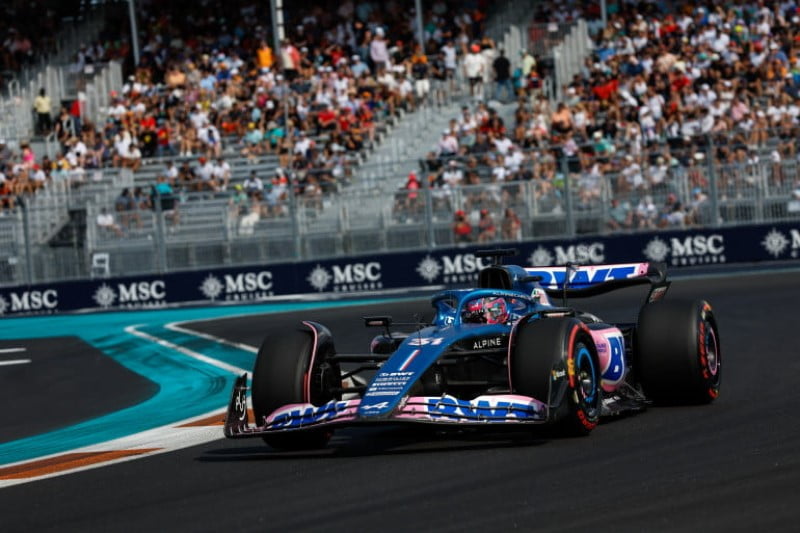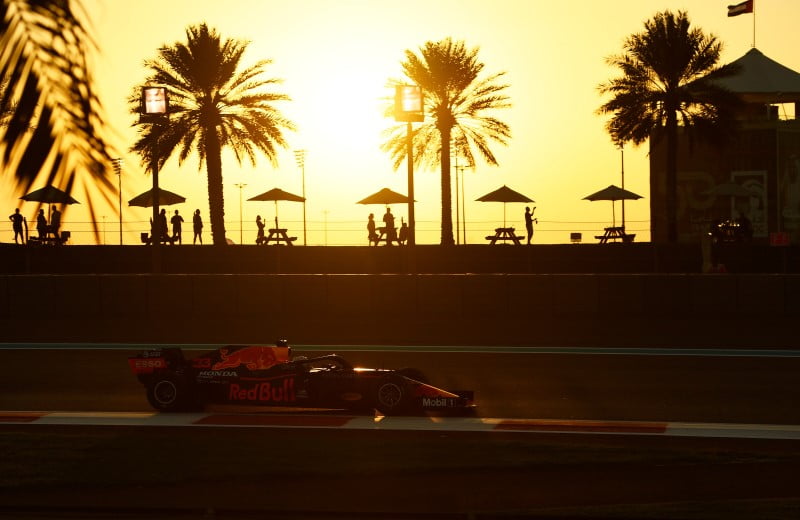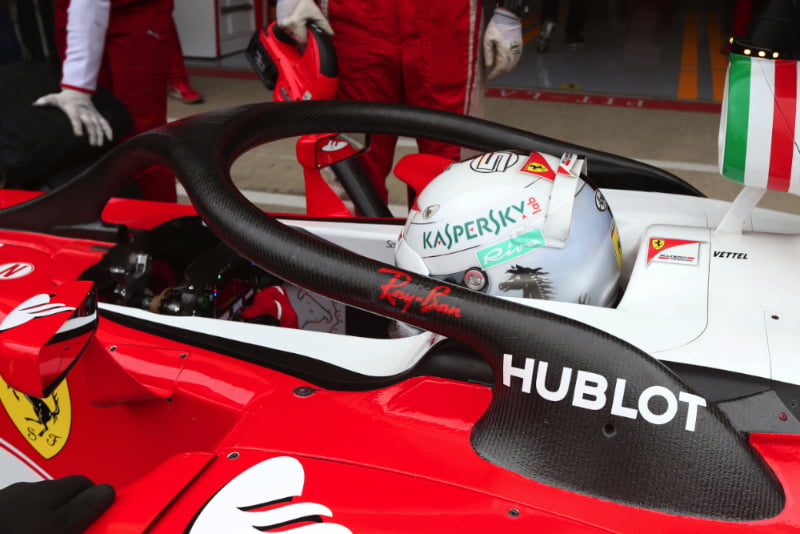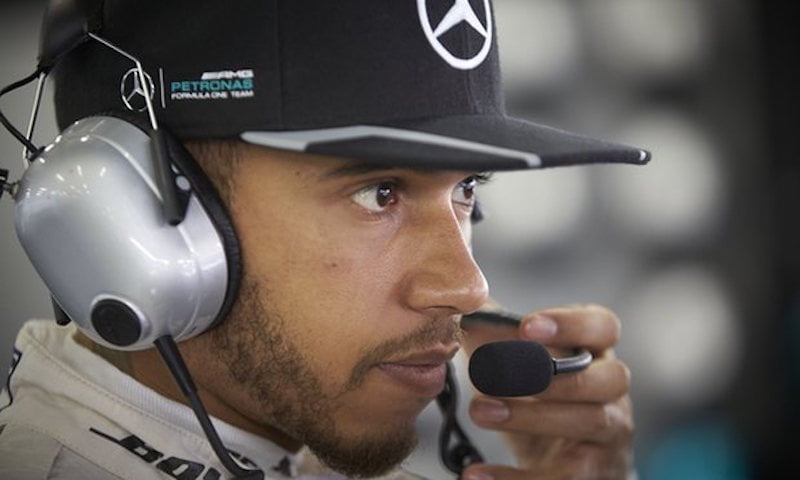2023 Miami Grand Prix
Budding Formula 1 tech-journalist Ashwin Issac pens his ‘F1 Midfield Tales’ from the 2023 Australian Grand Prix. ‘F1 Midfield Tales’ will be a combination of data and analysis that will aim to dissect the uber-competitive F1 midfield race-after-race.
Preface
This week for the fifth Grand Prix in the calendar, we arrive at the suburbs of Miami in Florida, ‘The Sunshine State’. The Formula 1 paddock is here for the first of the three Grand Prix in The United States of America.
The Miami International Autodrome is a temporary but purpose-built track around the ominous Hard Rock Stadium. This circuit is a parking lot track that appears during the race weekend.
The track layout is put together in a way that it comprises a combination of medium-high speed corners, slow-medium speed corners, and long straights. It’s a layout to which the teams can’t commit to a high downforce setup but to a medium-loaded configuration. The atmospheric conditions in Miami are proven to be a physically challenging aspect for the drivers, drawing parallels to Singapore.
After last year’s race, the drivers complained of the low-grip, bumpy nature of the circuit to which the race promoters obliged and completely resurfaced the track. This added an element of uncertainty to the teams in an already unfamiliar environment. The new surface was initially very slippery, and the lack of support series made the track not get cleaned quickly. The track did get rubbered up eventually but predictably on the racing line leaving the off-line still green, this meant the margin of error narrowed down for the drivers. This set the stage for track evolution to be a talking point for the weekend. The layout remains the same, but Formula 1 shortened the DRS activation zones 1 & 2 by 75 meters.
There is a lot to decode in this edition of the midfield tales. Let’s investigate how the weekend unfolded.
Observations
For the comparisons, data with similar variables are selected to make a viable analysis. For instance, the fastest sectors by a team and not individual drivers are considered for the qualifying analysis. Lap times are collected for the same tyre compound at identical periods of the race.
Qualifying
As expected, track evolution put the cat among pigeons in the qualifying session. The usual hierarchy was disturbed which was magnified by a late crash by Charles Leclerc. The final classification narrated a mixed picture with many drivers positioned out of their usual place.
Unusually apart from Perez, De Vries, and the McLarens, every other team recorded their fastest laps in Q2. Perez and Sainz were the only ones who set a time on new sets in Q3 with Sainz not improving. De Vries didn’t improve from his Q1 time in Q2. The McLarens didn’t qualify for Q2. The other drivers couldn’t complete their second run because of the crash.
Here’s a look at how the midfield teams fared in this session:
- Sector 1
The first sector is a collection of flowing, downforce-demanding corners bookended by major braking zones. This sector proved to be very pivotal in terms of the difference between drivers and teams.
- Valtteri Bottas was significantly fast in this sector, suggesting a higher downforce setup.
- The Alpine and the Haas were closely matched.
- Williams and Alpha Tauri set similar times.
- Contrary to the previous weekend the McLaren was the slowest of the lot.]
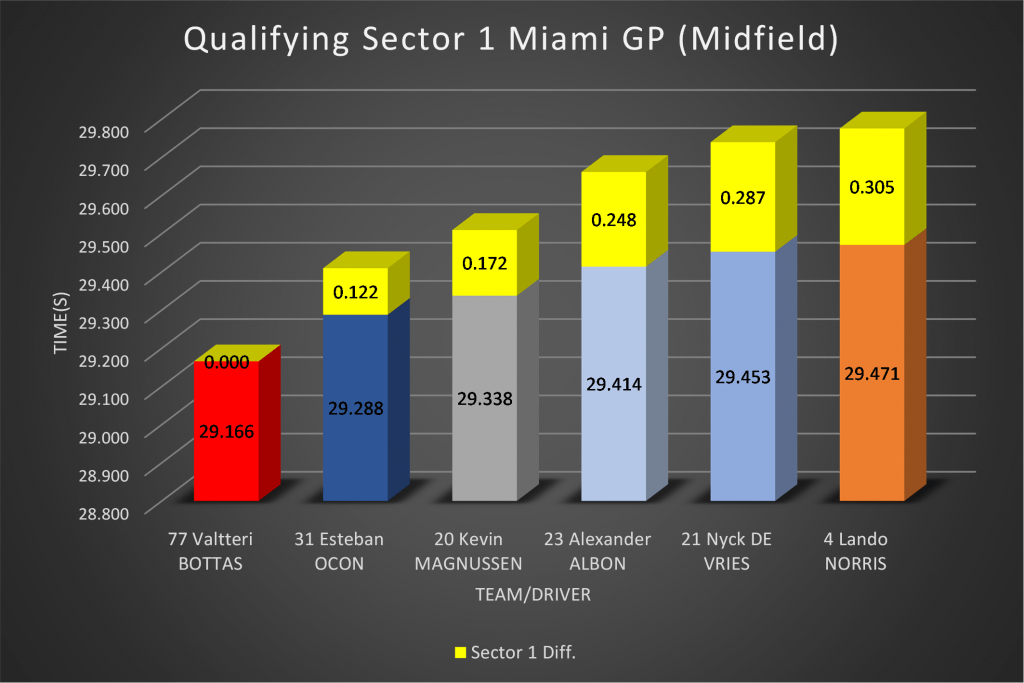
- Sector 2
This section of the track starts off with a significantly long meandering straight ending with a tight section of chicanes leading to the beginning of another long straight. Teams with higher aerodynamic efficiency or lower drag traits assisted with a good mechanical grip made good time in this sector.
- Esteban Ocon took the honours in this sector for Alpine, they found a good compromise in their setup to optimize this sector.
- The Ferrari-powered duo didn’t lose a lot of time in this section with Bottas making good time at the end of the sector.
- The Drag affected McLaren struggled in this section.
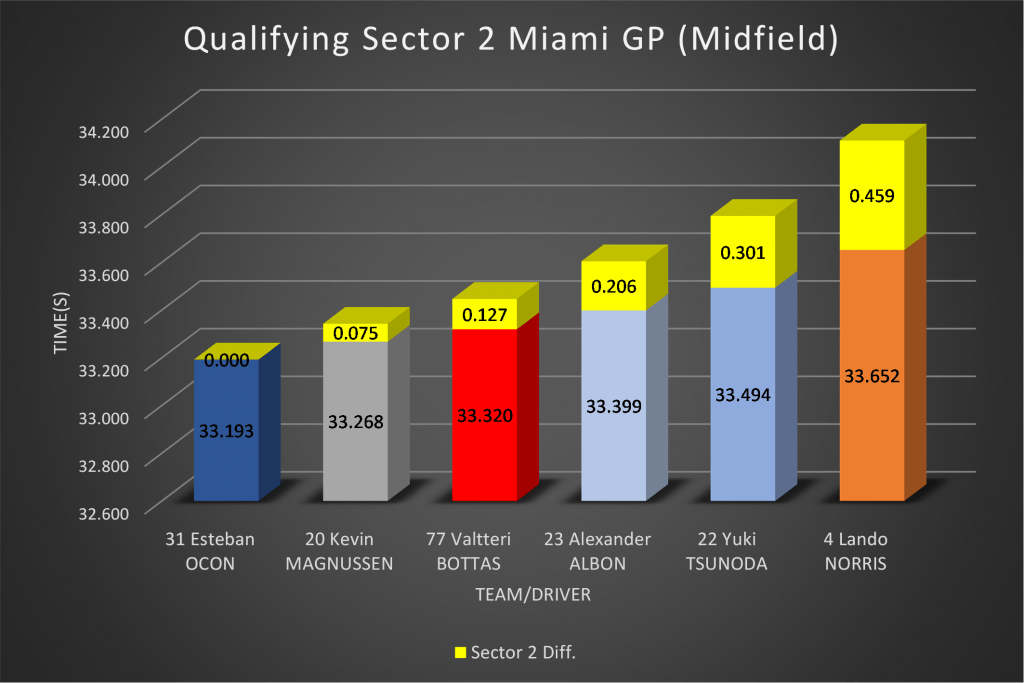
- Sector 3
The final sector begins with a significant straight leading to a heavy braking zone followed by a short meandering burst to the start-finish line. This section again benefits the team that has aerodynamically efficient cars and cars that don’t have ‘dirty downforce’.
- This sector was the most competitive part of the track with four of the teams not losing a lot to each other.
- McLaren and Alpha Tauri lost a couple of tenths attributing to their drag.
- Alpha seemed to have lost their straight-line speed from Baku.
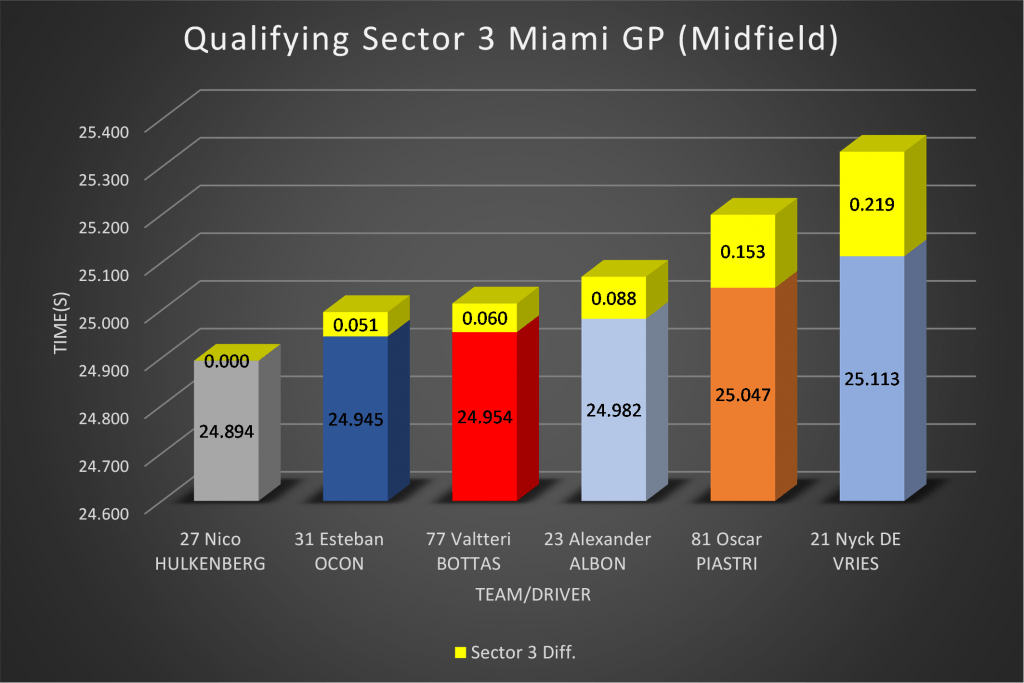
Carrying on from the analysis above to further understand the characteristics of each car, here is a mini-sector comparison of all the midfield teams. The graph below gives a visualization of each team’s advantages at different segments of the track.
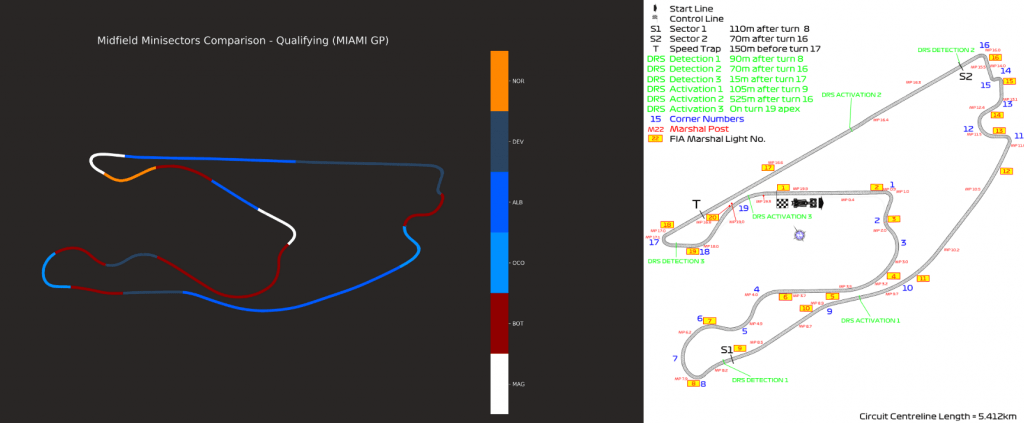
The ramping track evolution was the highlight of the qualifying session which caught many drivers and teams off guard even though it was expected on a newly resurfaced track that has no significant running on it.
On a look at the data from the session, the time difference after every run from the cars was enormous, especially through Q1, where a few cars at the end of the session improved by more than a second from their first run.
The lap times continued to fall through Q2. Below is a chart that depicts the time gained by the teams from Q1 to Q2. McLaren failed to qualify for Q2 and hence their times are excluded.
Apart from De Vries, every other team improved on their Q1 times with a few clocking times that were four-tenths faster.
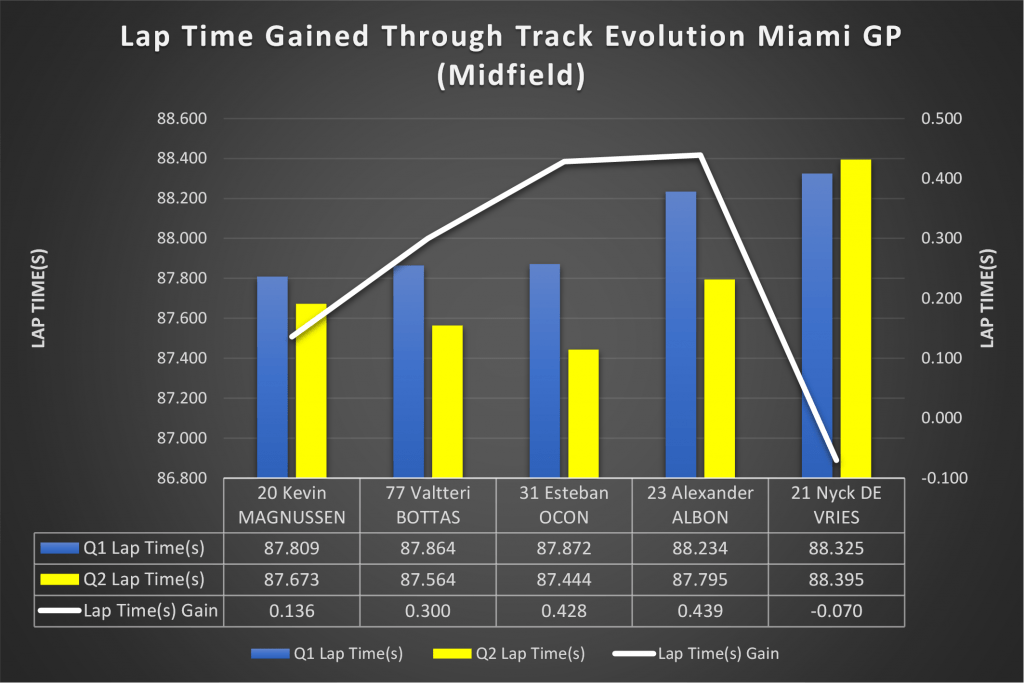
The Race
As the paddock and the garages closed down after the qualifying session, Miami was subjected to a downpour, the track was even flooded at a few places. All the previous rubber that was laid on the track was washed away, asking the teams a new question.
The circuit with its new surface was estimated to be a one-stop race with the medium and hard compounds as the choice of tyres. With the washed, green track that estimation was lacking confidence.
There was also a threat of further rain during the course of the race but the intensity and the time were unsure.
The drivers were almost split with the tyre of choice between the hard tyres and the medium tyres but McLaren was an exception, they opted to start both their drivers on the soft tyres.
The softs seemed to work for Piastri who got a blistering start but was hampered by technical problems with his brakes and Norris failed to make an impression. Both of them pitted very early into the race and bolted on new hard tyres, which they took to the end.
The medium starters suffered a lot of graining initially and their times were similar to the hard starters and then they started losing time prompting early pitstops. The drivers on hard tyres realized that their tyres were performing well under the conditions and there was no significant time loss due to the low wear rate, these drivers held on to them as long as they could.
The hard tyres turned out to be the best racing compound for the weekend.
The charts below visualise how the midfield teams performed through the race with respect to the compound of tyres.
- Stint 1 (Medium Tyres)
- There were a lot of changes in positions during this stint with a few out-of-place drivers moving up the field.
- The Alpine of Gasly was consistently the fastest among the midfield.
- Nyck De Vries in his Alpha Tauri was consistently the slowest.
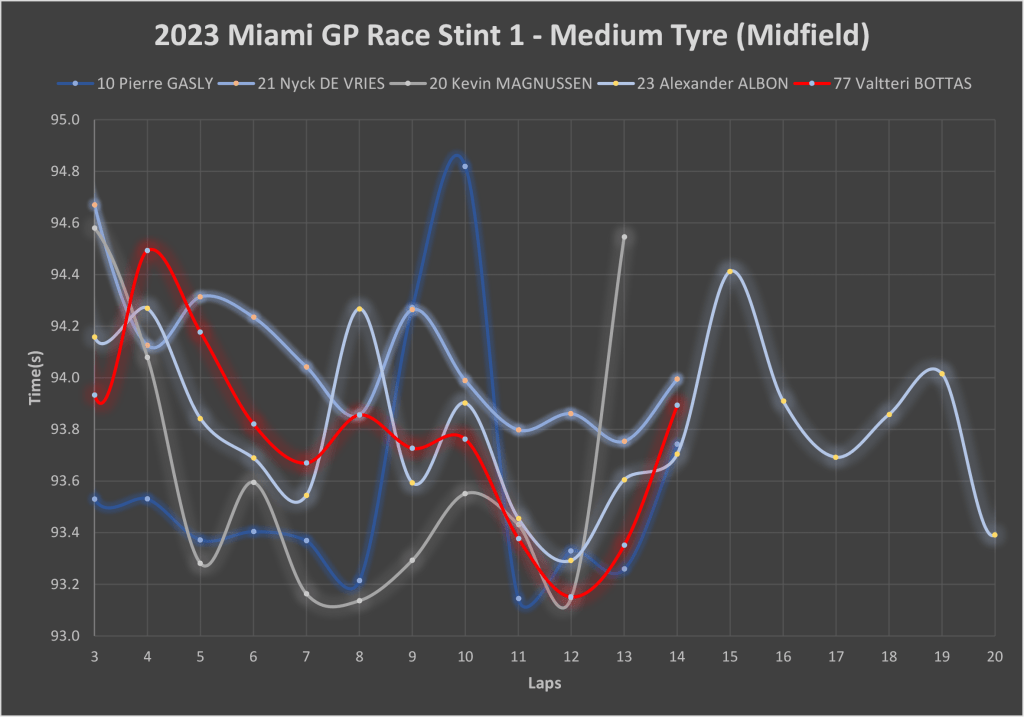
- Stint 1 (Hard Tyres)
- The laps were inconsistent due to the change in positions
- The Alpine of Ocon was again the fastest in this stint.
- The Alpha Tauri and Haas almost matched each other on this compound.
- Zhou was in the mix but fell out later in the stint.
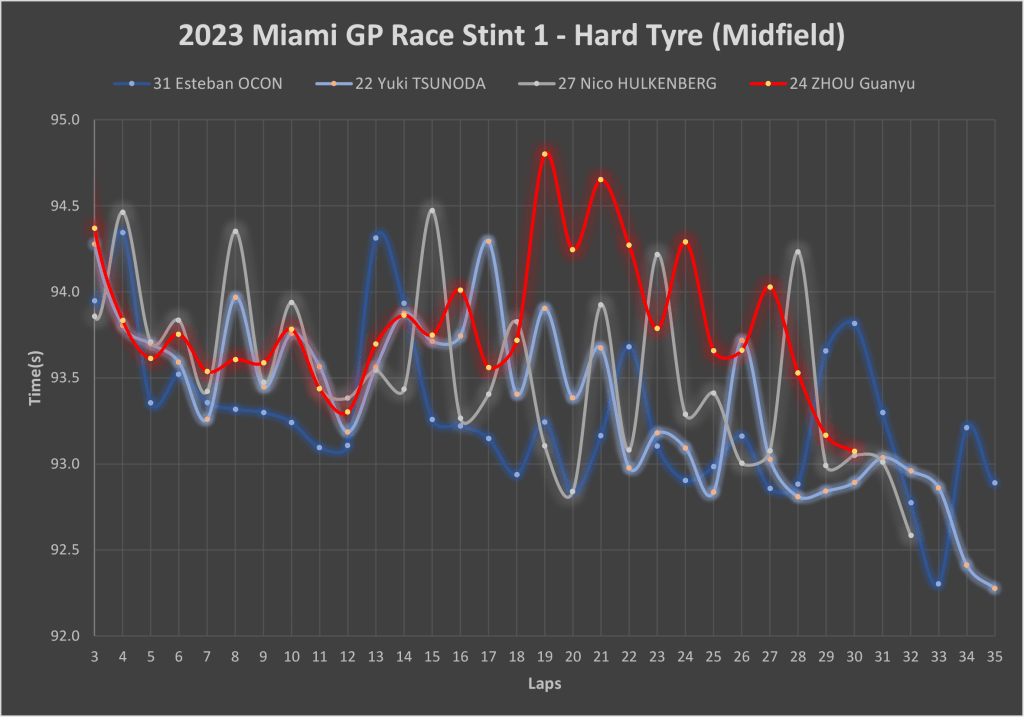
- Stint 2 (Medium Tyres)
- It is clearly evident that the Alpine has a clear advantage, also attributed by a later change in tyres.
- The Haas and Alpha were matching times initially but the Haas later fell behind.
- Zhou’s Alfa was the most consistent car but with average lap times.
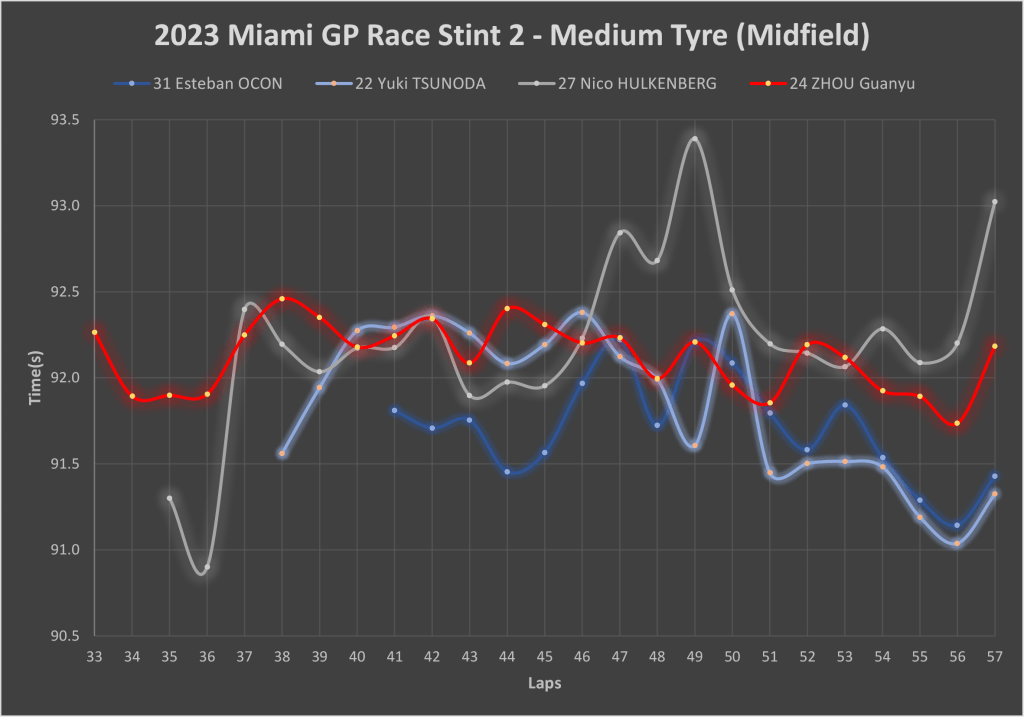
- Stint 2 (Hard Tyres)
- On average Gasly’s Alpine takes the honours for this stint.
- The Alpha and Haas are yet again having matching lap times with the Williams of Albon and the Alfa of Bottas joining the fray.
- This chart is an attribute to the consistent performance offered by the hard tyres.
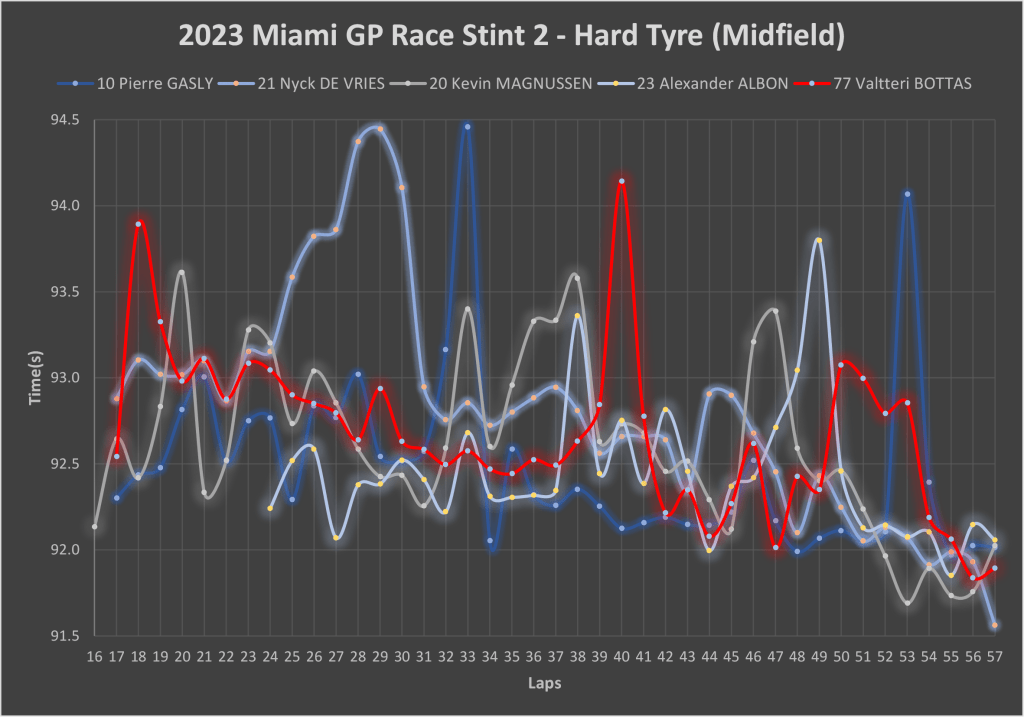
The grid was predominantly split between two strategies. To determine which was the better, faster strategy is not straightforward because the race winner who made his start on the hard tyres made it work excellently but that race winner was Max Verstappen, was it more the strategy or was it more the driver that made the difference?
To ascertain a winner among the strategies let’s observe the lap times of the Alfa Romeo drivers, they were split in their tyre choices and their laps were fairly consistent. Of course, a driver can make a difference but for analytical purposes, this seemed to be an even ground.
On the chart below it can be observed that initially there was no time difference between the two compounds but when Valtteri Bottas switched to the hard tyres and when Zhou was still continuing in his hard tyres, there was a significant difference. When Zhou switched to the medium tyres, even though there was an advantage, this advantage was not significant enough.
Bottas’s hard tyres held on nicely till the end, if the medium tyres had worked as expected in the beginning the advantage would have been bigger in this case.
There were other teams who had reversed results making it difficult to come to the right conclusion.
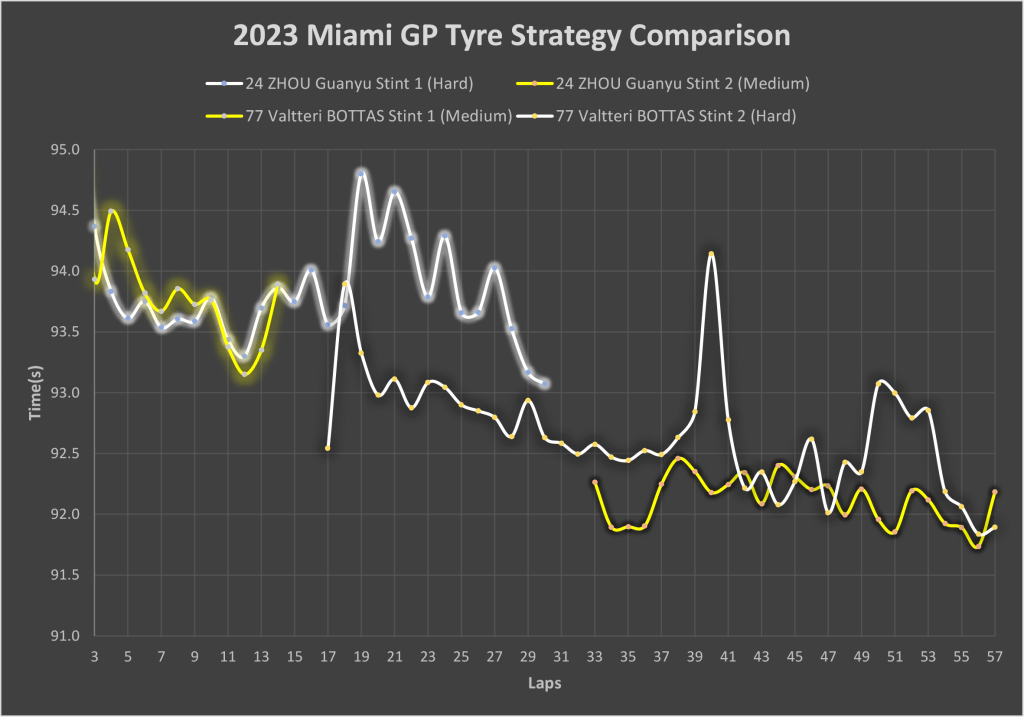
Conclusion
The Miami Grand Prix is turning out to be a desirable destination for the rich and the famous to experience the thrills of a Formula 1 weekend.
The traditional format was back leaving us to ponder if we miss the sprint format which offered us an important session to view every day of the weekend.
Nevertheless, for enthusiasts, any Formula 1 weekend is a joy and an honour.
The qualifying session was atypical as the grid was shuffled significantly. The race was sufficiently entertaining highlighted by a stellar performance by the inevitable Max Verstappen. There were enough overtakes and strategy differences that avoided a stalemate.
As for the midfield, the pecking order yet again saw some changes. McLaren was thought to have made some progress with their new floor but their weekend in Miami put them at the doldrums of the midfield, Norris blamed the high track temperatures, if that was a factual reason then they will be expected to overturn their status in the next race week.
The highly criticised Alpine team had a weekend to cheer about. They had a pace that challenged the Ferraris and the drivers post-race were very optimistic about their progress. They are expected to maintain their performance given that they have a clean weekend.
The Alpha Tauri struggle in one lap pace but are right in the mix in race pace at least in the hands of Yuki Tsunoda. They have to sort out their qualifying performance and De Vries has to step up to play his part effectively.
It is the opposite for Haas as they possess stellar one-lap pace but are plagued by tyre wear.
Alfa had a better weekend with Valtteri Bottas making a case for his critics. On the whole, this track seemed to have suited their car, their true potential is yet to be seen.
There is no Formula 1 action next week but after that, we go into a triple header. There is speculation that a plethora of updates are expected by most teams. The Midfield is as close as ever, let’s look ahead to what narrative will be set in the coming weeks.
